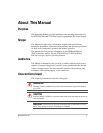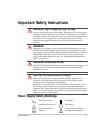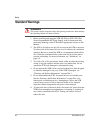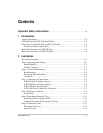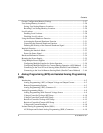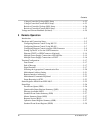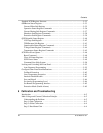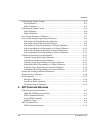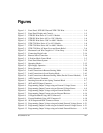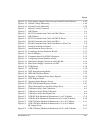
Contents
xii 975-0200-01-01
Voltage-Controlled Voltage ISOL Setup - - - - - - - - - - - - - - - - - - - - - - - - - - 4–22
Voltage-Controlled Current ISOL Setup - - - - - - - - - - - - - - - - - - - - - - - - - - - 4–23
Resistive-Controlled Voltage ISOL Setup - - - - - - - - - - - - - - - - - - - - - - - - - - 4–26
Resistive-Controlled Current ISOL Setup - - - - - - - - - - - - - - - - - - - - - - - - - - 4–27
Voltage and Current Readback (Isolated)- - - - - - - - - - - - - - - - - - - - - - - - - - - - - 4–29
5
Remote Operation
Introduction - - - - - - - - - - - - - - - - - - - - - - - - - - - - - - - - - - - - - - - - - - - - - - - - -5–2
Hardware and Connection Setup- - - - - - - - - - - - - - - - - - - - - - - - - - - - - - - - - - - -5–2
Configuring Remote Control Using RS-232 - - - - - - - - - - - - - - - - - - - - - - - - -5–2
Configuring Remote Control Using RS-485 - - - - - - - - - - - - - - - - - - - - - - - - -5–7
Configuring Remote Control using the USB Connector - - - - - - - - - - - - - - - - -5–9
Setting Up the PC to Use the USB Connection - - - - - - - - - - - - - - - - - - - - - - -5–9
Ethernet (ENET) or GPIB Connector (Optional) - - - - - - - - - - - - - - - - - - - - - 5–14
Multiple Power Supply Connections to RS-485 Bus - - - - - - - - - - - - - - - - - - - 5–15
Multiple Power Supply Connections to ENET - - - - - - - - - - - - - - - - - - - - - - - 5–16
Terminal Configuration- - - - - - - - - - - - - - - - - - - - - - - - - - - - - - - - - - - - - - - - - 5–17
Data Format - - - - - - - - - - - - - - - - - - - - - - - - - - - - - - - - - - - - - - - - - - - - - - 5–17
End of Message - - - - - - - - - - - - - - - - - - - - - - - - - - - - - - - - - - - - - - - - - - - 5–17
HyperTerminal - - - - - - - - - - - - - - - - - - - - - - - - - - - - - - - - - - - - - - - - - - - - 5–17
Selecting the Appropriate Communication Port - - - - - - - - - - - - - - - - - - - - - - 5–20
Multichannel Address Setting - - - - - - - - - - - - - - - - - - - - - - - - - - - - - - - - - - 5–21
Remote Interface Addressing - - - - - - - - - - - - - - - - - - - - - - - - - - - - - - - - - - 5–21
Multichannel Commands Explained - - - - - - - - - - - - - - - - - - - - - - - - - - - - - 5–22
Status Reporting in SCPI - - - - - - - - - - - - - - - - - - - - - - - - - - - - - - - - - - - - - 5–23
Status Registers Model from IEEE 488.2- - - - - - - - - - - - - - - - - - - - - - - - - - - - - 5–25
Status Byte - - - - - - - - - - - - - - - - - - - - - - - - - - - - - - - - - - - - - - - - - - - - - - - - - 5–26
Error/Event Queue (ERR) - - - - - - - - - - - - - - - - - - - - - - - - - - - - - - - - - - - - 5–26
Questionable Status Register Summary (QSR) - - - - - - - - - - - - - - - - - - - - - - 5–26
Message Available (MAV) - - - - - - - - - - - - - - - - - - - - - - - - - - - - - - - - - - - - 5–27
Standard Event Status Summary (ESB) - - - - - - - - - - - - - - - - - - - - - - - - - - - 5–27
Master Summary Status (MSS) - - - - - - - - - - - - - - - - - - - - - - - - - - - - - - - - - 5–27
Request Service (RQS) - - - - - - - - - - - - - - - - - - - - - - - - - - - - - - - - - - - - - - 5–27
Operation Status Register Summary (OSR) - - - - - - - - - - - - - - - - - - - - - - - - - 5–27
Standard Event Status Register (SESR) - - - - - - - - - - - - - - - - - - - - - - - - - - - 5–29




